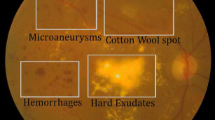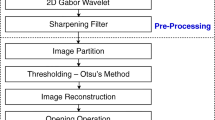Abstract
Retinal vessel in fundus image is segmented with a comprehensive method for classification. The method is processed in four phases namely, preprocessing, segmentation, features extraction and classification, this method can be used on different images sets. Retinal vessels are enhanced by brightness preserving dynamic fuzzy histogram equalization (BPDFHE), separating enhanced image is used to detect the retinal diseases. Then these enhanced images are segmented by using quincunx wavelet decomposition for extracting features like first order statistics and gray level co-occurrence matrix (GLCM). The feature vector encodes information to handle the normal and abnormal retinal image and those features are classified using different classifiers (Adaboost, DSVM, ELMASR, EPLS, KNN, NB, NBFFS, OCPLS, RBFN, RF, SOWA, SVM and SVNN) and the performance is evaluated in detail. Blood vessel segmentation with this method is effective for retinal image computational analyses such as early retinal disease detection. Experimental results on three public retinal data sets like DRIVE, STARE and MESSIDOR and real time images are taken from Agarwal’s Eye Hospital, Tirunelveli, demonstrating an excellent performance in comparison with retinal vessel segmentation methods reported recently.





Similar content being viewed by others
Change history
30 May 2022
This article has been retracted. Please see the Retraction Notice for more detail: https://doi.org/10.1007/s12652-022-03989-5
References
Abdullah-Al-Wadud M, Kabir MH, Dewan MAA, Chae O (2007) A dynamic histogram equalization for image contrast enhancement. IEEE Trans. Consum Electron 53:593–600
Antonini M, Barlaud M, Mathieu P, Daubechies I (1992) Image coding using wavelet transform. IEEE Trans Image Process 1:205–220
Bai Z, Huang GB, Wang D, Wang H, Westover H (2014) Sparse extreme learning machine for classification. IEEE Trans Cybern 44:1858–1870
Bai T, Li YF, Zhou X (2015) Learning local appearances with sparse representation for robust and fast visual tracking. IEEE Trans Cybern 45:663–675
Balasubramanian K, Ananthamoorthy NP (2019) Robust retinal blood vessel segmentation using convolutional neural network and support vector machine. J Ambient Intell Hum Comput. https://doi.org/10.1007/s12652-019-01559-w
Cao J, Zhang K, Luo M, Yin Lai X (2016) Extreme learning machine and adaptive sparse representation for image classification. Neural Networks 81:91–102
Chen S-D, Ramli AR (2003a) Minimum mean brightness error bi-histogram equalization in contrast enhancement. IEEE Trans Consum Electron 49:1310–1319
Chen S-D, Ramli AR (2003b) Contrast enhancement using recursive mean-separate histogram equalization for scalable brightness preservation. IEEE Trans Consum Electron 49:1301–1309
Daubechies I, Sweldens W (1998) Factoring wavelet transforms into lifting steps. J Fourier Anal Appl 4:247–269
Donoho D, Johnstone I (1994) Ideal spatial adaptation via wavelet shrinkage. Biometrica 81:425–455
Do MN, Vetterli M (2001) Pyramidal directional filter banks and curvelets. Proc Int Conf Image Process Thessaloniki Greece 3:158–161
DRIVE: digital retinal images for vessel extraction (2004) https://www.isi.uu.nl/Research/Databases/DRIVE/
Gadekallu TR, Khare N, Bhattacharya S (2020) Deep neural networks to predict diabetic retinopathy. J Ambient Intell Hum Comput. https://doi.org/10.1007/s12652-020-01963-7
Gonzalez RC, Woods RE (2002) digital image processing, 2nd edn. Prentice Hall, USA, pp 91–95
Gouze A, Antonini M, Barlaud M (2000) Quincunx lifting scheme for lossy image coding. IEEE Proc Int Conf Image Proc 1:665–668
Huang G, Huang GB, Song S, You K (2015) Trends in extreme learning machines: a review. Neural Netw 61:32–48
Ibrahim H, Kong NSP (2007) Brightness preserving dynamic histogram equalization for image contrast enhancement. IEEE Trans Consum Electron 53:4
Joseph T, Kalaiselvan SA, Aswathy SU (2020) A multimodal biometric authentication scheme based on feature fusion for improving security in cloud environment. J Ambient Intell Hum Comput. https://doi.org/10.1007/s12652-020-02184-8
Karthiyayini R, Geetha S (2020) An automated neural network based technique for identifying fundus hemorrhage (NNTFH). J Ambient Intell Hum Comput. https://doi.org/10.1007/s12652-020-02168-8
Kovacevic J, Sweldens W (2000) Wavelet families of increasing order in arbitrary dimensions. IEEE Trans Image Process 9:480–496
Merino D, Loza-Alvarez P (2016) Adaptive optics scanning laser opthalmoscope imaging: technology update. Clin Opththalmol 10:743–755
MESSIDOR: methods for evaluating segmentation and indexing techniques dedicated to retinal ophthalmology (2004) https://www.isi.uu.nl/Research/Databases/MESSIDOR
Sarrafzadeh A, Rezazadeh F, Shanbehzadeh J (2013) Brightness preserving fuzzy dynamic histogram equalization. Proc Int Multi Conf Eng Comput Sci 1:13–15
Sersic D, Vrankic M (2002) 2-D non separable wavelet filter bank with adaptive filter parameters. Proc EUSIPCO 1:137–140
STARE: Structured Analysis of the Retina (2004) https://www.isi.uu.nl/Research/Databases/STARE
Ullaha H, Islam N, Jan Z (2018) Optic disc segmentation and classification in color fundus images: a resource-aware healthcare service in smart cities. J Ambient Intell Hum Comput. https://doi.org/10.1007/s12652-018-0988-8
Valarmathi R, Saravanan S (2019) Exudate characterization to diagnose diabetic retinopathy using generalized method. J Ambient Intell Hum Comput. https://doi.org/10.1007/s12652-019-01617-3
Vetterli M (2001) Wavelets, approximation and compression. IEEE Sig Proc Mag 8:59–73
Wan Yu, Chen Q, Zhang B-M (1999) Image enhancement based on equal area dualistic sub-image histogram equalization method. IEEE Trans Consum Electron 45:68–75
Yanoff M, Duker JS (2018) Opthalmology E-book. Elesvier Health Sciences, Netherlands
Yeong TK (1997) Contrast enhancement using brightness preserving bi-histogram equalization. IEEE Trans Consum Electron 43:1–8
Author information
Authors and Affiliations
Corresponding author
Additional information
This article has been retracted. Please see the retraction notice for more detail: https://doi.org/10.1007/s12652-022-03989-5"
About this article
Cite this article
Sathya, N., Rathika, N. RETRACTED ARTICLE: Different classification methods of fundus image segmentation using quincunx wavelet decomposition. J Ambient Intell Human Comput 12, 6947–6953 (2021). https://doi.org/10.1007/s12652-020-02340-0
Received:
Accepted:
Published:
Issue Date:
DOI: https://doi.org/10.1007/s12652-020-02340-0




